Abstract
1. The relationship between intracellular metabolites and the generation of force during fatigue has been examined in the first dorsal interosseous muscle of the hand. With the arm made ischaemic, the muscle was fatigued by three bouts of maximal voluntary contraction, leaving approximately three minutes ischaemic rest between contractions. During one series of experiments intracellular phosphorus metabolites were measured by nuclear magnetic resonance during the intervals between the fatiguing contractions: in the second series contractile properties were tested with brief electrical stimulation during the rest intervals. 2. The relationships between loss of force and change in metabolite concentrations obtained with four normal subjects were compared with those from one subject with myophosphorylase deficiency (MPD) who could not utilize muscle glycogen and therefore produced no hydrogen ion from glycolysis during exercise. 3. For both the MPD and normal subjects the relationship between relative force loss and inorganic phosphate (Pi) concentration was curvilinear, force changing little in the early stages of the contraction when the intracellular Pi was accumulating rapidly but falling faster when the Pi was above 25 mM and increasing relatively slowly. 4. In the normal subjects intracellular pH fell from a mean of 7.03 +/- 0.01 (mean +/- S.E. of mean, n = 19) in the fresh muscle to 6.51 +/- 0.02 at the end of the fatiguing exercise; force, as a percentage of the initial value, fell in proportion to the increase in H+ concentration. In the MPD subject pH did not change and force loss was therefore independent of H+ accumulation. In the normal subjects the force of the fatiguing muscle showed an approximately linear relationship with the concentration of the monobasic form of inorganic phosphate. However, the MPD subject showed a quite different relationship, with force loss being much greater for a given concentration of monobasic phosphate. This result indicates that monobasic phosphate is not a unique determinant of force loss in fatigued muscle. 5. During the first 60 s of recovery in the normal subjects, pH remained low while force recovered, indicating a mechanism of force loss that was independent of H+ accumulation. However, the recovery of force was not complete, so that for comparable phosphocreatine contents the recovering, more acid, muscle generated less force than the muscle that was being fatigued. It was estimated that H(+)-dependent and independent mechanisms contributed roughly equally to the observed force loss. The relationship between force and the concentration of monobasic phosphate differed in fatiguing and recovering muscle.
Full text
PDF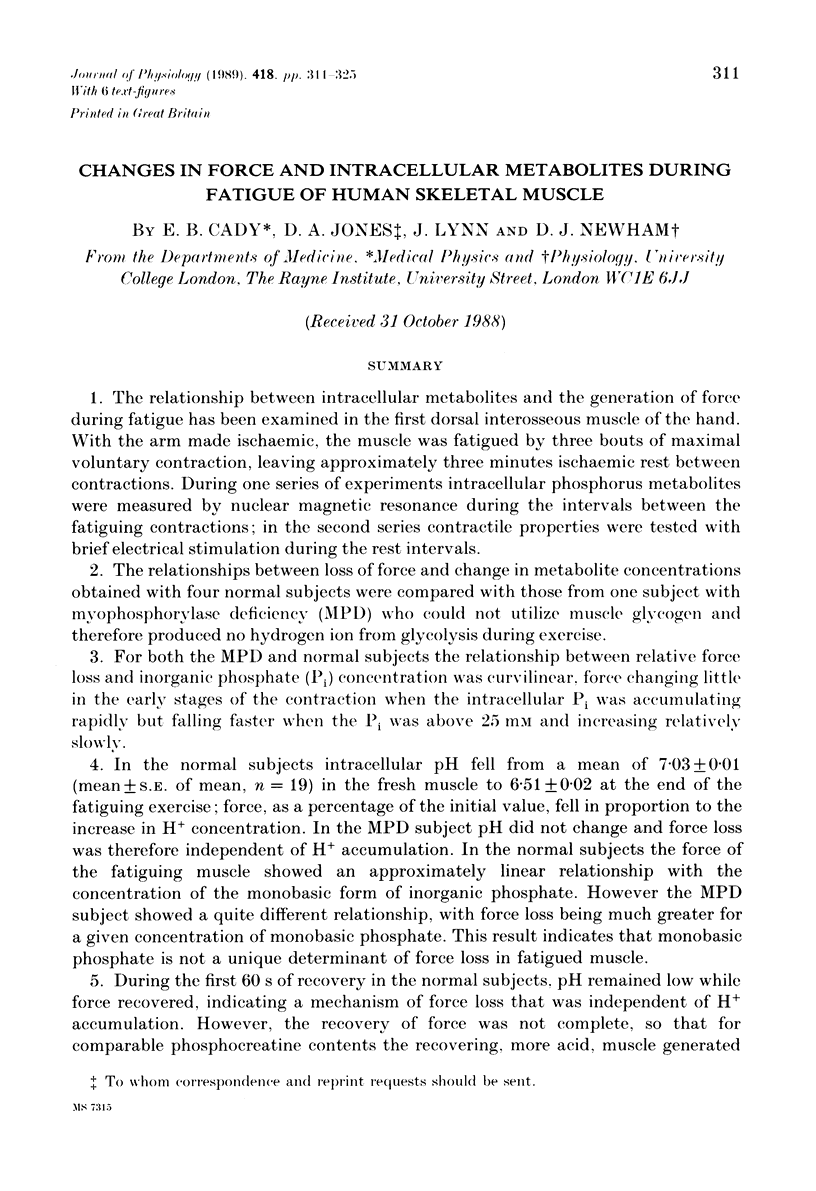
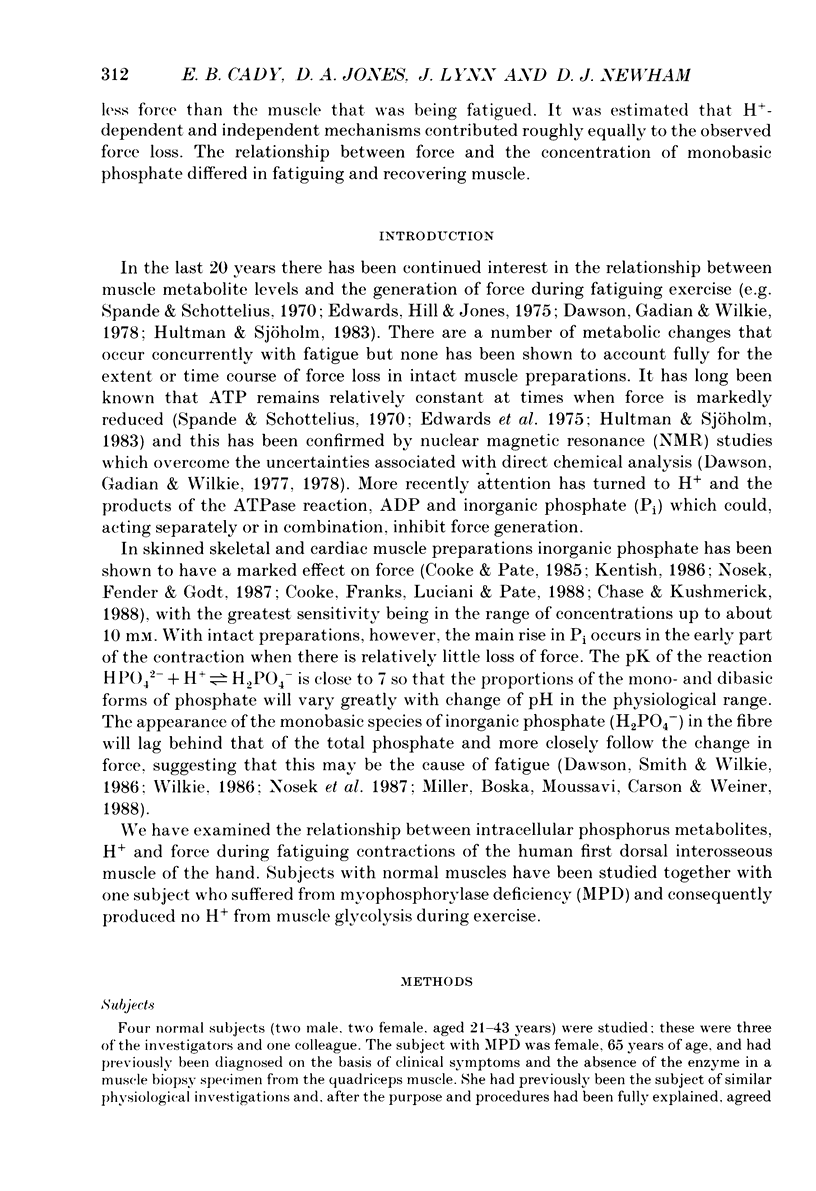
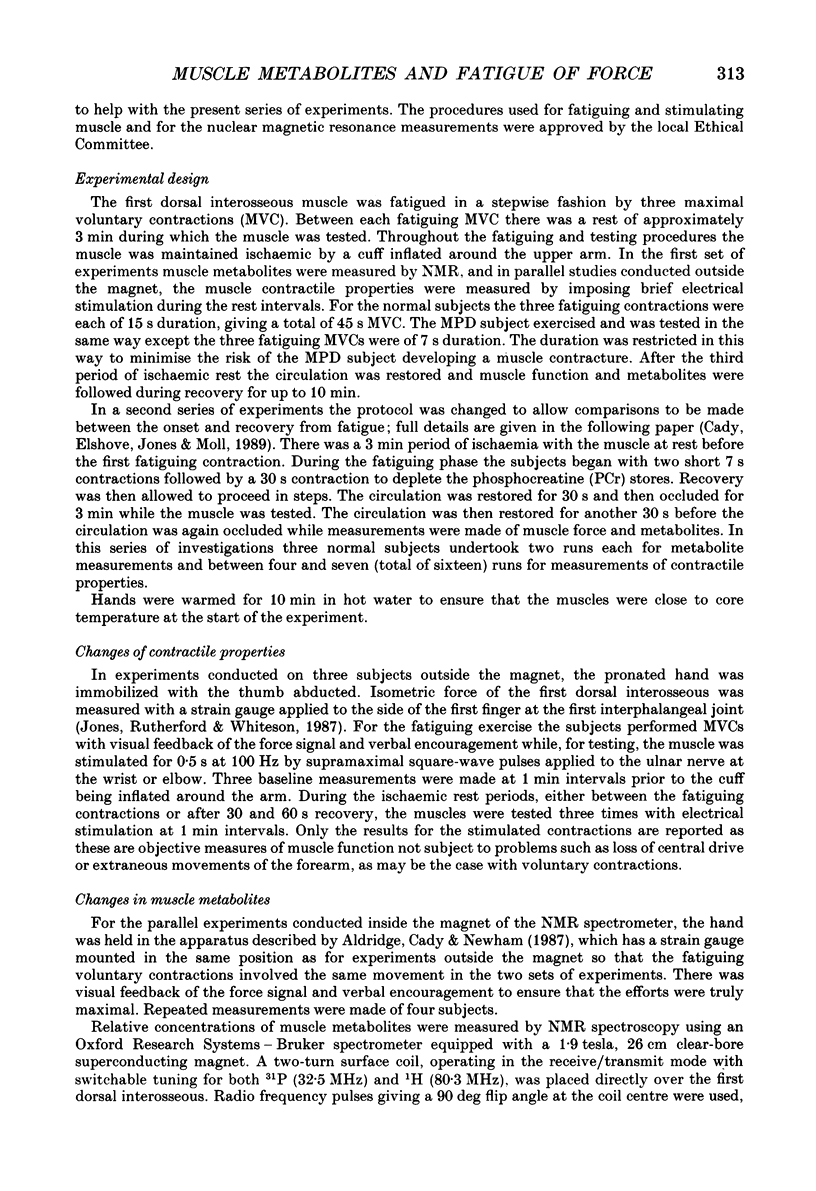
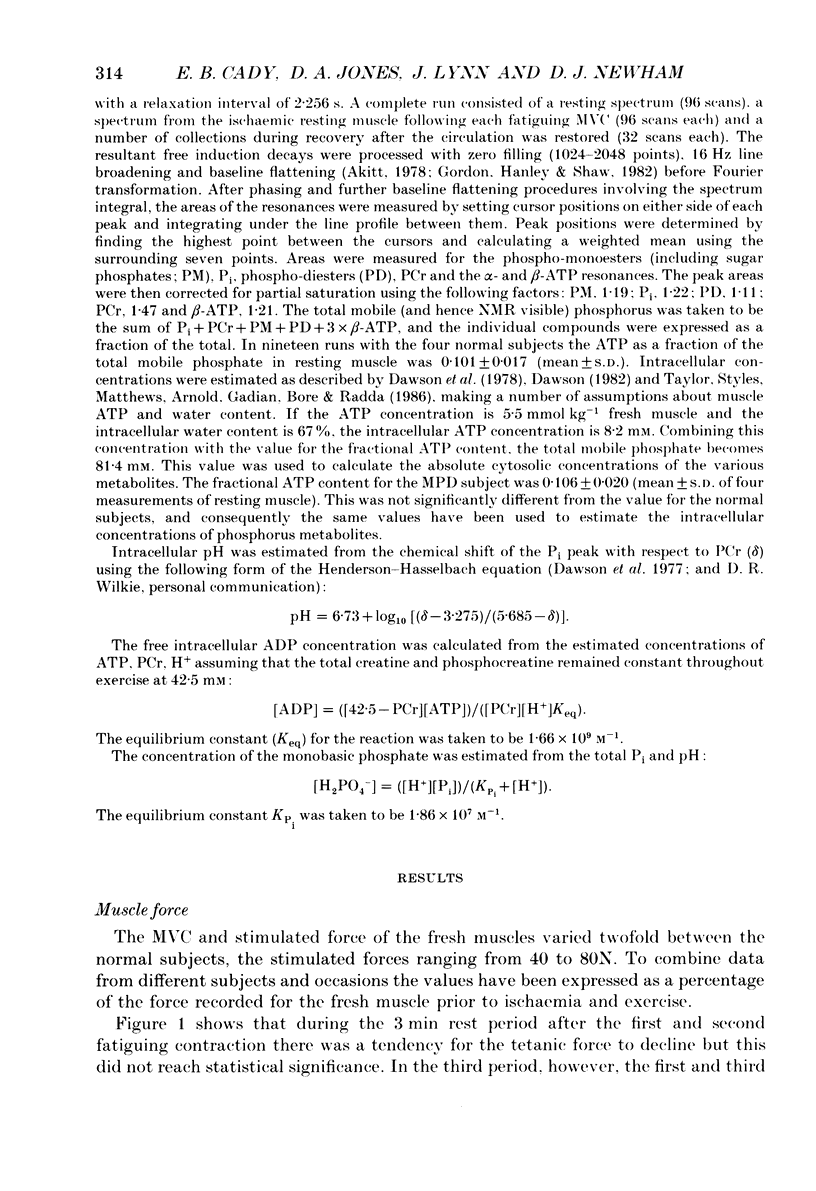
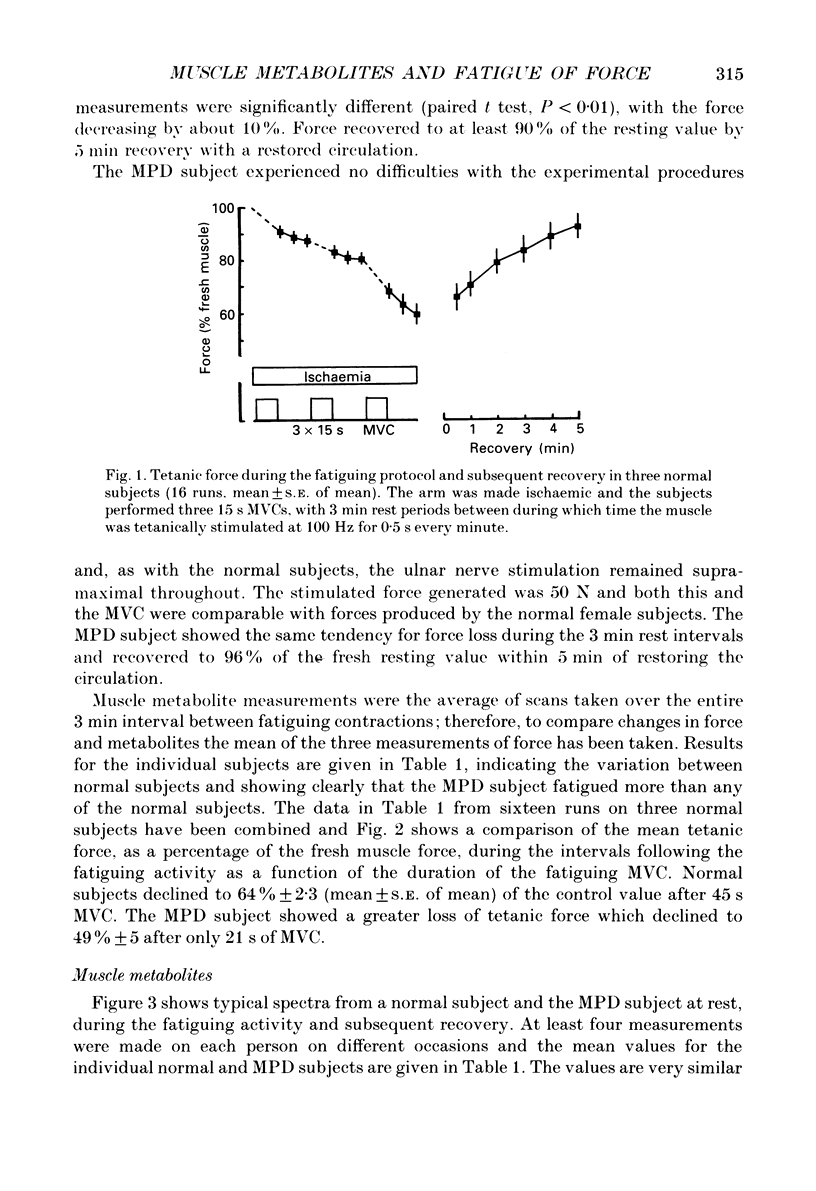
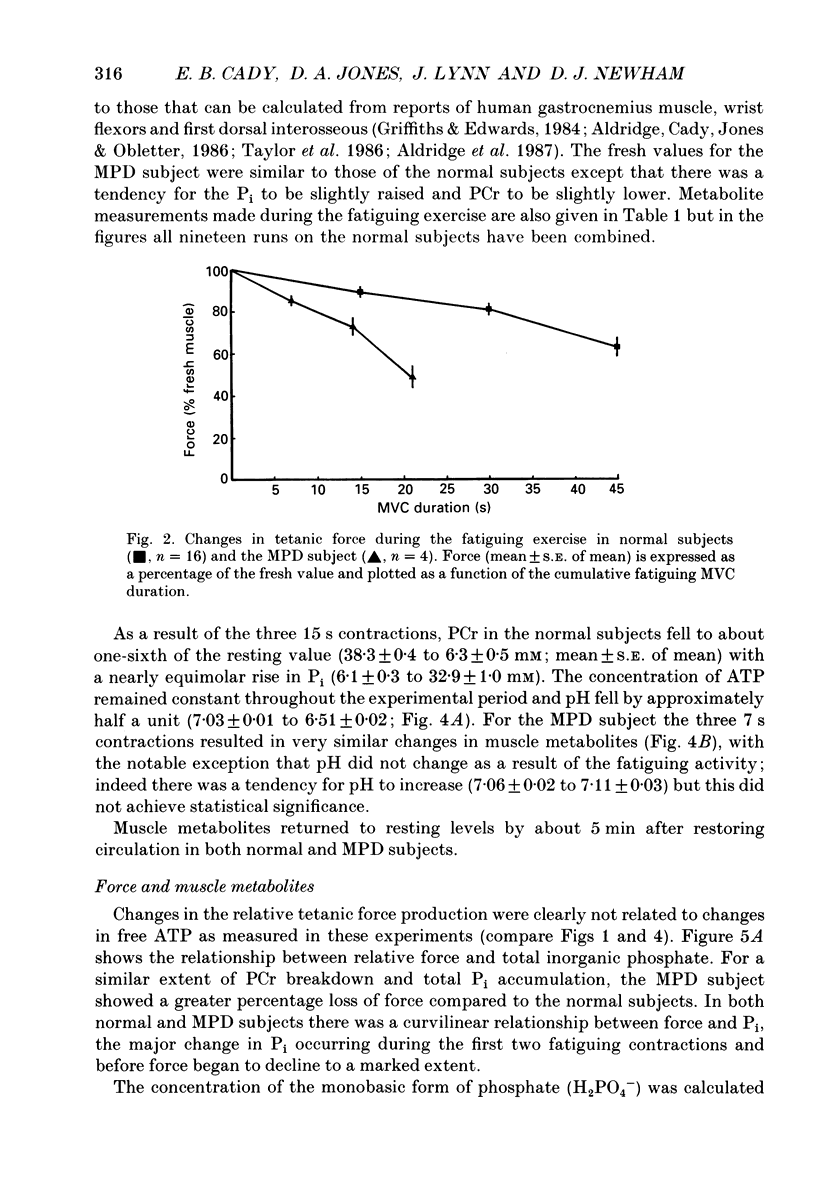

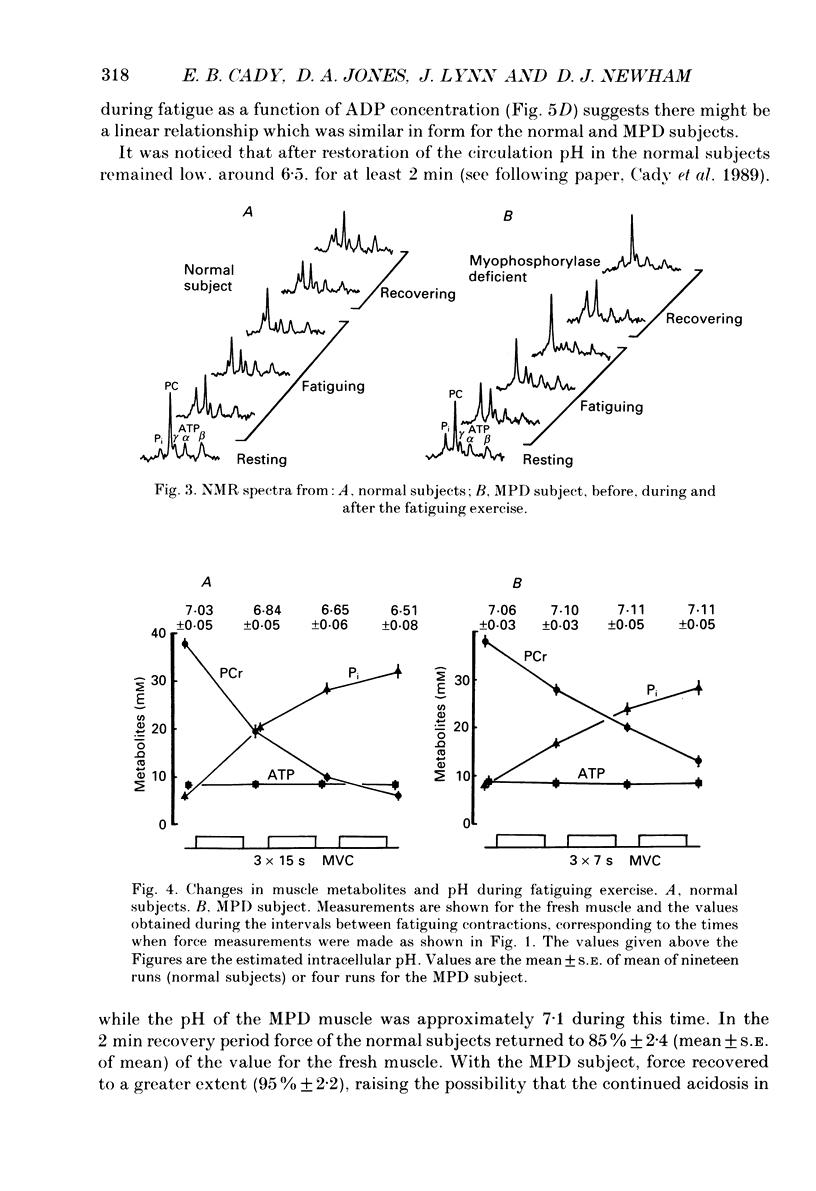
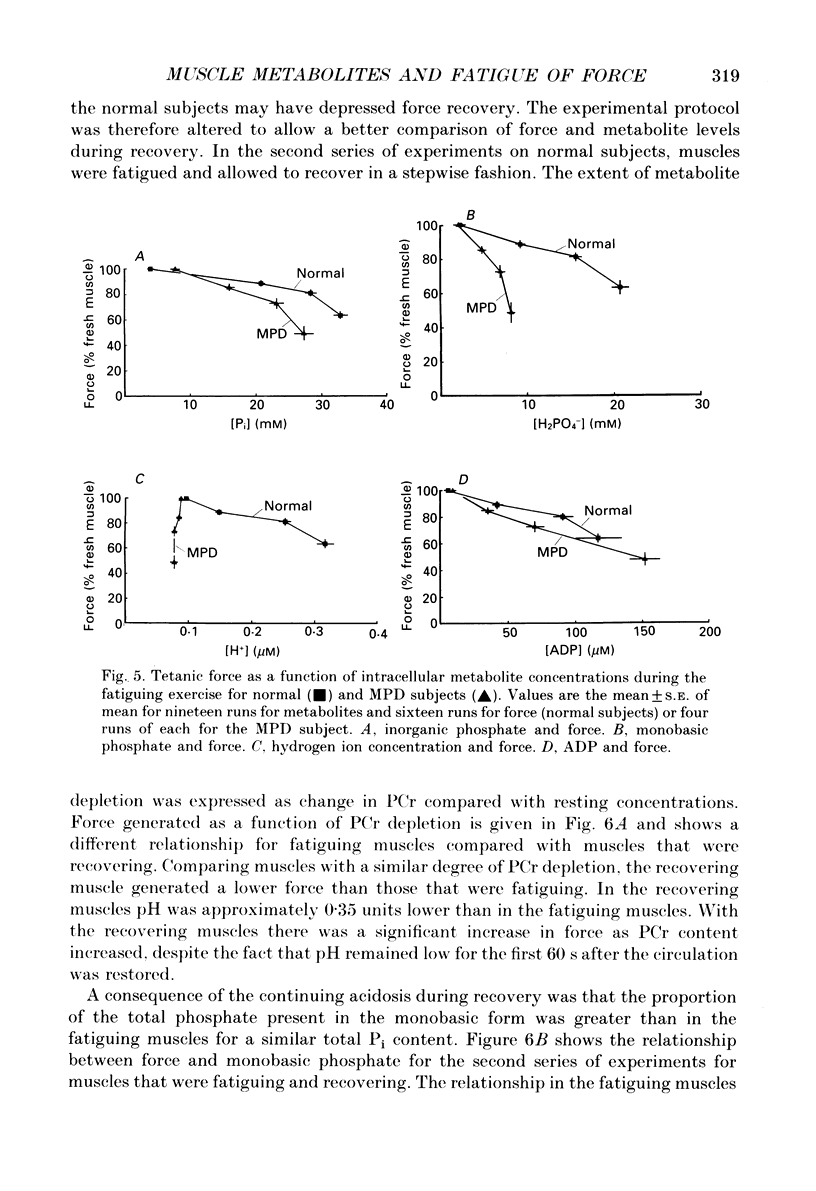

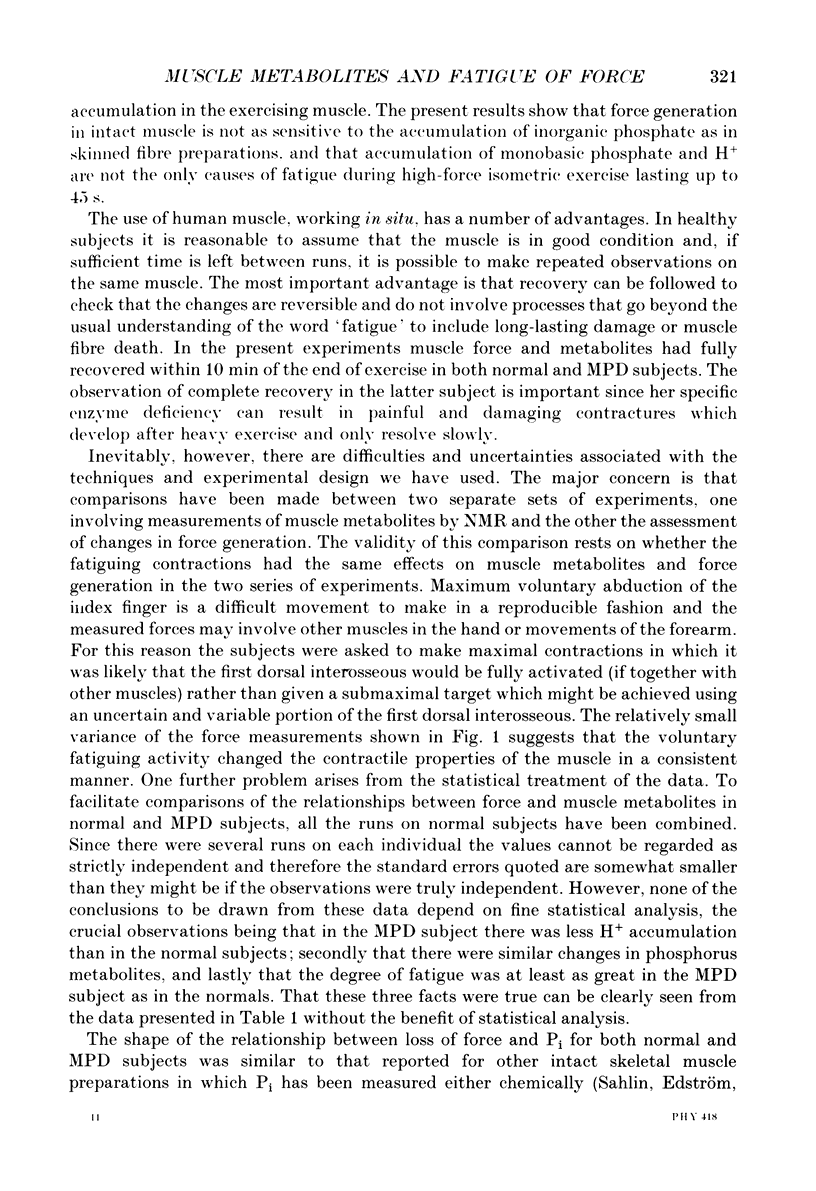
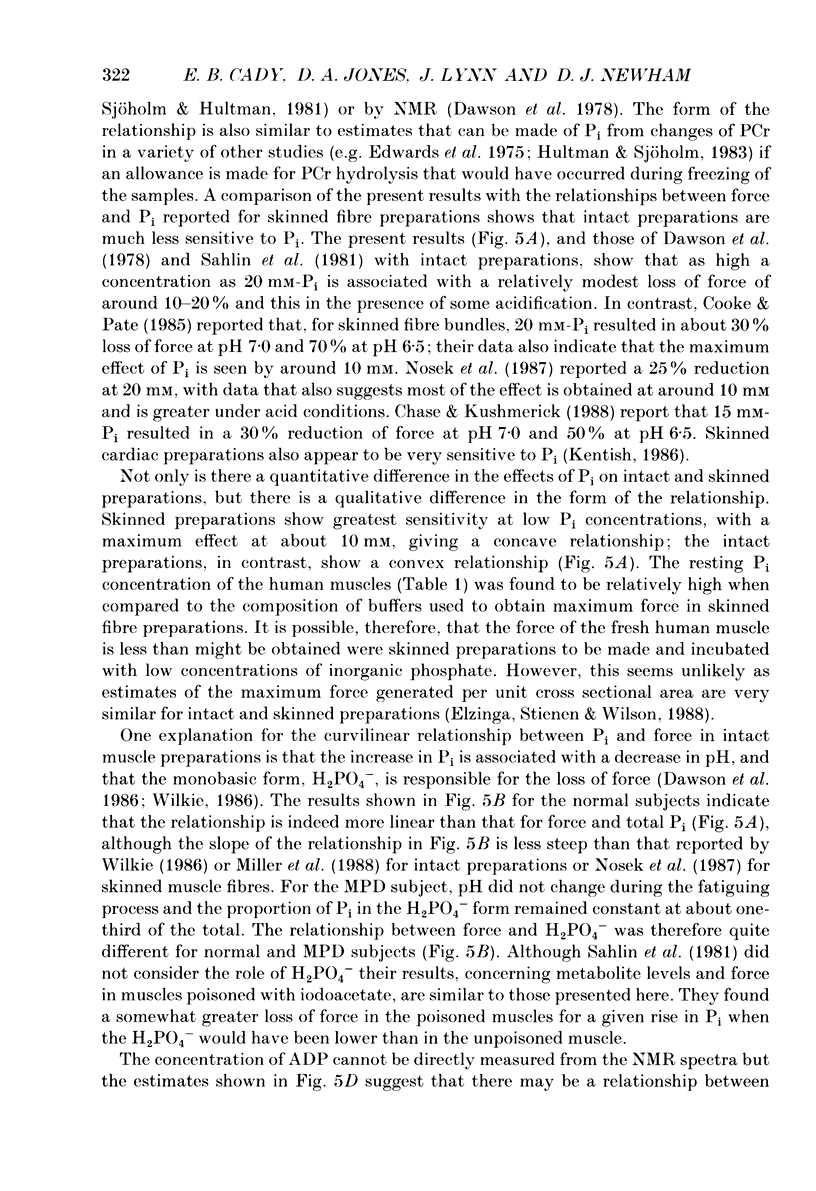
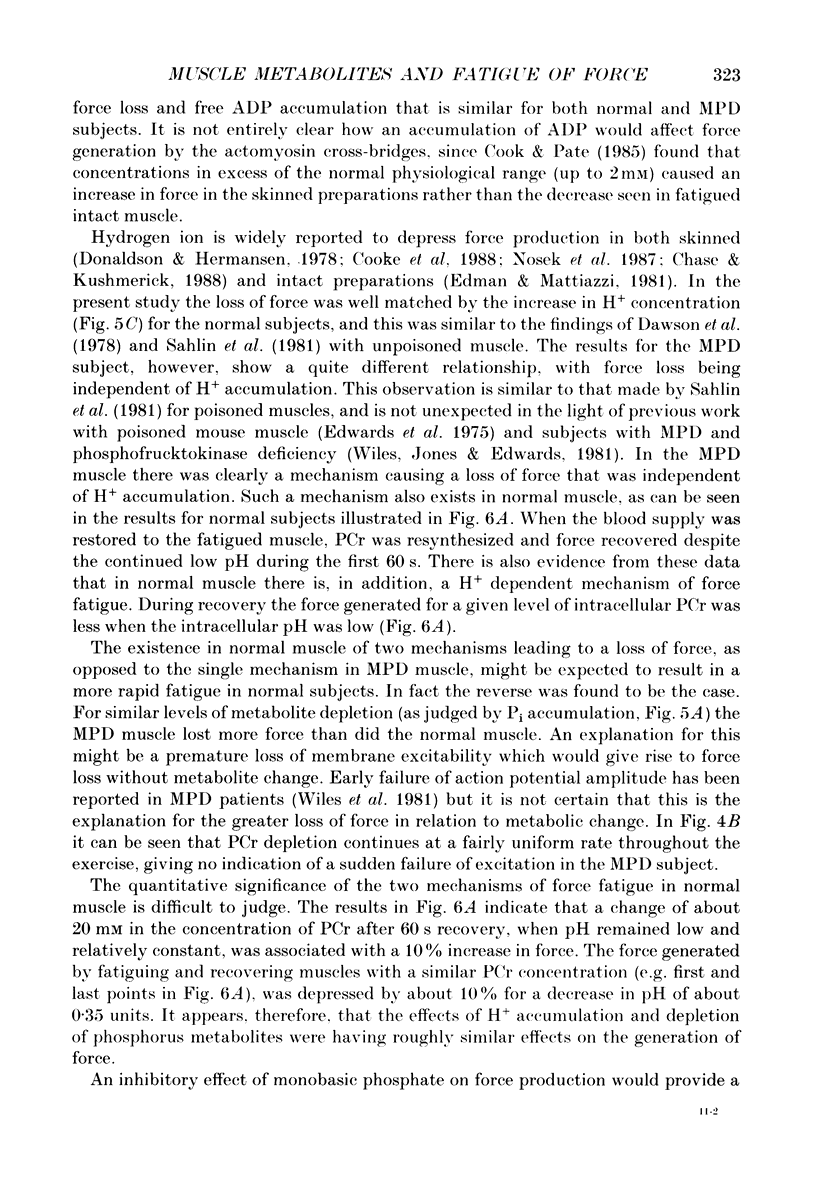
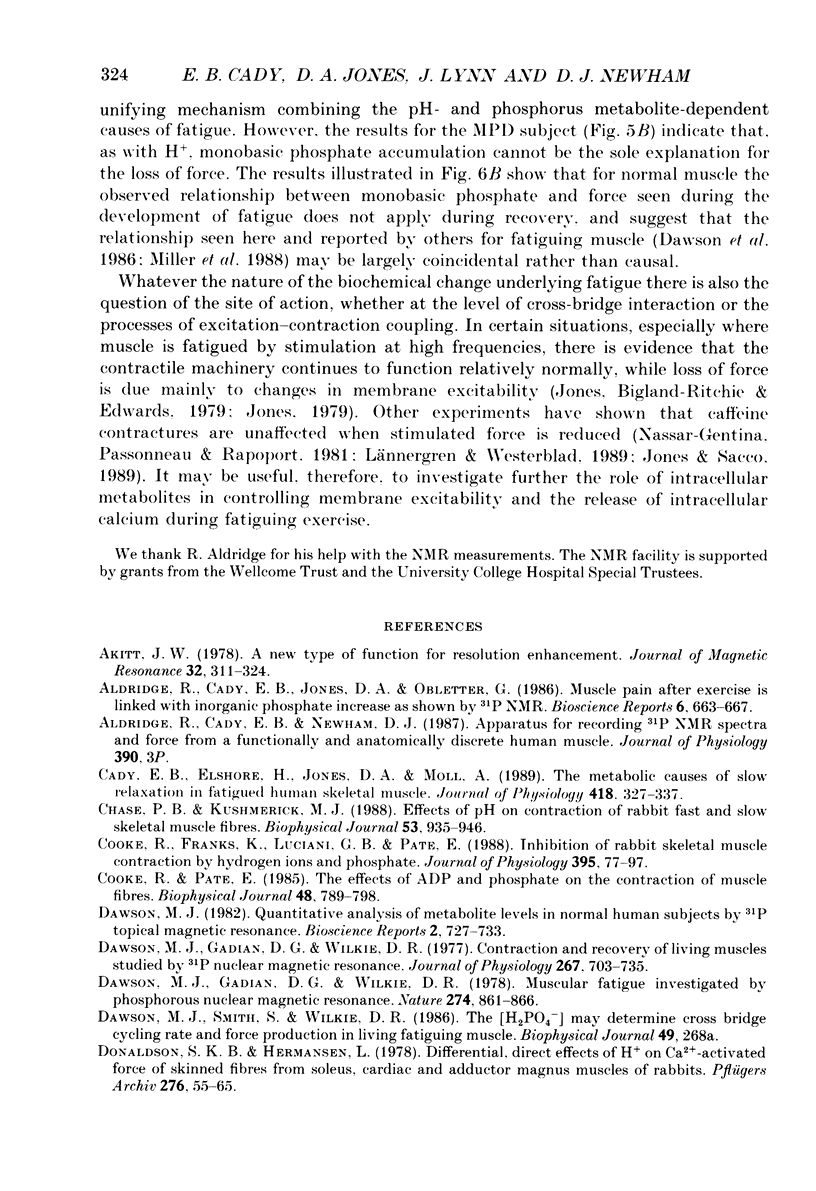
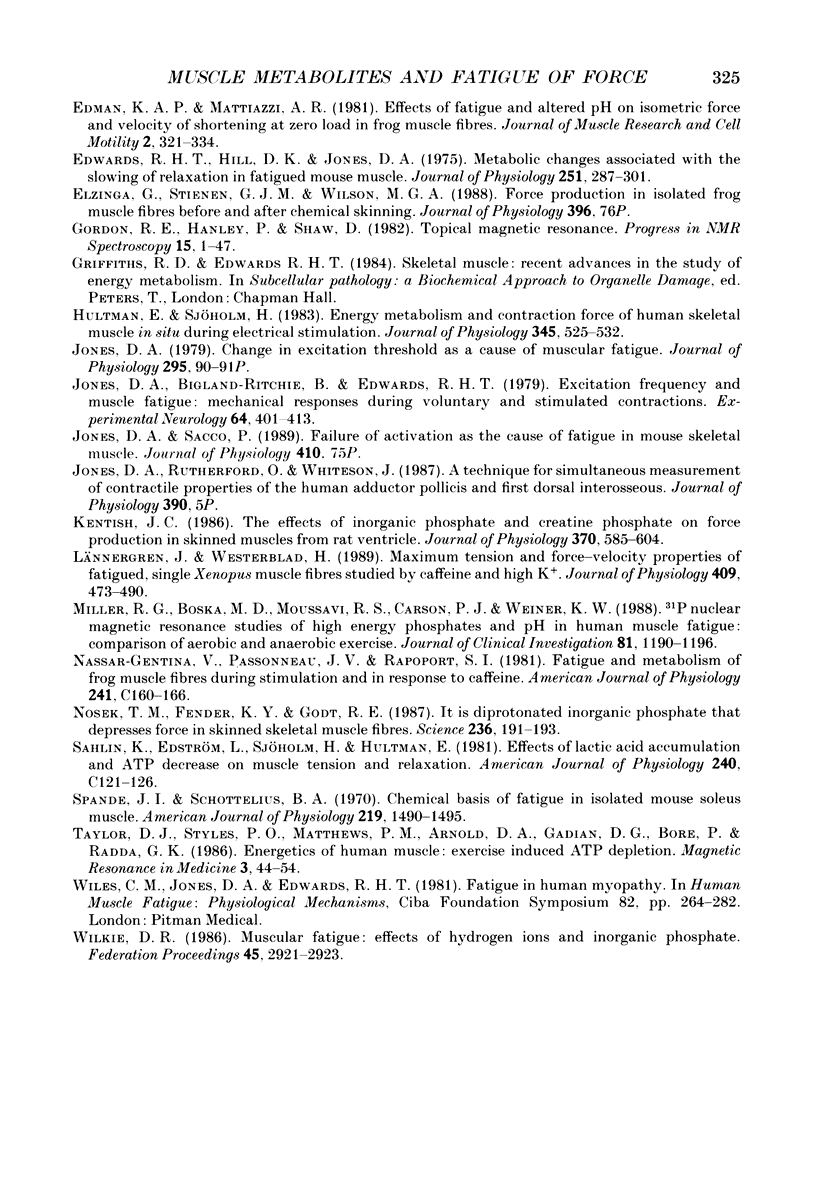
Selected References
These references are in PubMed. This may not be the complete list of references from this article.
- Aldridge R., Cady E. B., Jones D. A., Obletter G. Muscle pain after exercise is linked with an inorganic phosphate increase as shown by 31P NMR. Biosci Rep. 1986 Jul;6(7):663–667. doi: 10.1007/BF01114761. [DOI] [PubMed] [Google Scholar]
- Cady E. B., Elshove H., Jones D. A., Moll A. The metabolic causes of slow relaxation in fatigued human skeletal muscle. J Physiol. 1989 Nov;418:327–337. doi: 10.1113/jphysiol.1989.sp017843. [DOI] [PMC free article] [PubMed] [Google Scholar]
- Chase P. B., Kushmerick M. J. Effects of pH on contraction of rabbit fast and slow skeletal muscle fibers. Biophys J. 1988 Jun;53(6):935–946. doi: 10.1016/S0006-3495(88)83174-6. [DOI] [PMC free article] [PubMed] [Google Scholar]
- Cooke R., Franks K., Luciani G. B., Pate E. The inhibition of rabbit skeletal muscle contraction by hydrogen ions and phosphate. J Physiol. 1988 Jan;395:77–97. doi: 10.1113/jphysiol.1988.sp016909. [DOI] [PMC free article] [PubMed] [Google Scholar]
- Cooke R., Pate E. The effects of ADP and phosphate on the contraction of muscle fibers. Biophys J. 1985 Nov;48(5):789–798. doi: 10.1016/S0006-3495(85)83837-6. [DOI] [PMC free article] [PubMed] [Google Scholar]
- Dawson M. J., Gadian D. G., Wilkie D. R. Contraction and recovery of living muscles studies by 31P nuclear magnetic resonance. J Physiol. 1977 Jun;267(3):703–735. doi: 10.1113/jphysiol.1977.sp011835. [DOI] [PMC free article] [PubMed] [Google Scholar]
- Dawson M. J., Gadian D. G., Wilkie D. R. Muscular fatigue investigated by phosphorus nuclear magnetic resonance. Nature. 1978 Aug 31;274(5674):861–866. doi: 10.1038/274861a0. [DOI] [PubMed] [Google Scholar]
- Dawson M. J. Quantitative analysis of metabolite levels in normal human subjects by 31P topical magnetic resonance. Biosci Rep. 1982 Sep;2(9):727–733. doi: 10.1007/BF01114836. [DOI] [PubMed] [Google Scholar]
- Edman K. A., Mattiazzi A. R. Effects of fatigue and altered pH on isometric force and velocity of shortening at zero load in frog muscle fibres. J Muscle Res Cell Motil. 1981 Sep;2(3):321–334. doi: 10.1007/BF00713270. [DOI] [PubMed] [Google Scholar]
- Edwards R. H., Hill D. K., Jones D. A. Metabolic changes associated with the slowing of relaxation in fatigued mouse muscle. J Physiol. 1975 Oct;251(2):287–301. doi: 10.1113/jphysiol.1975.sp011093. [DOI] [PMC free article] [PubMed] [Google Scholar]
- Hultman E., Sjöholm H. Energy metabolism and contraction force of human skeletal muscle in situ during electrical stimulation. J Physiol. 1983 Dec;345:525–532. doi: 10.1113/jphysiol.1983.sp014994. [DOI] [PMC free article] [PubMed] [Google Scholar]
- Jones D. A., Bigland-Ritchie B., Edwards R. H. Excitation frequency and muscle fatigue: mechanical responses during voluntary and stimulated contractions. Exp Neurol. 1979 May;64(2):401–413. doi: 10.1016/0014-4886(79)90279-6. [DOI] [PubMed] [Google Scholar]
- Jones D. A. Change in excitation threshold as a cause of muscular fatigue [proceedings]. J Physiol. 1979 Oct;295:90P–91P. [PubMed] [Google Scholar]
- Kentish J. C. The effects of inorganic phosphate and creatine phosphate on force production in skinned muscles from rat ventricle. J Physiol. 1986 Jan;370:585–604. doi: 10.1113/jphysiol.1986.sp015952. [DOI] [PMC free article] [PubMed] [Google Scholar]
- Lännergren J., Westerblad H. Maximum tension and force-velocity properties of fatigued, single Xenopus muscle fibres studied by caffeine and high K+. J Physiol. 1989 Feb;409:473–490. doi: 10.1113/jphysiol.1989.sp017508. [DOI] [PMC free article] [PubMed] [Google Scholar]
- Miller R. G., Boska M. D., Moussavi R. S., Carson P. J., Weiner M. W. 31P nuclear magnetic resonance studies of high energy phosphates and pH in human muscle fatigue. Comparison of aerobic and anaerobic exercise. J Clin Invest. 1988 Apr;81(4):1190–1196. doi: 10.1172/JCI113434. [DOI] [PMC free article] [PubMed] [Google Scholar]
- Nassar-Gentina V., Passonneau J. V., Rapoport S. I. Fatigue and metabolism of frog muscle fibers during stimulation and in response to caffeine. Am J Physiol. 1981 Sep;241(3):C160–C166. doi: 10.1152/ajpcell.1981.241.3.C160. [DOI] [PubMed] [Google Scholar]
- Nosek T. M., Fender K. Y., Godt R. E. It is diprotonated inorganic phosphate that depresses force in skinned skeletal muscle fibers. Science. 1987 Apr 10;236(4798):191–193. doi: 10.1126/science.3563496. [DOI] [PubMed] [Google Scholar]
- Sahlin K., Edström L., Sjöholm H., Hultman E. Effects of lactic acid accumulation and ATP decrease on muscle tension and relaxation. Am J Physiol. 1981 Mar;240(3):C121–C126. doi: 10.1152/ajpcell.1981.240.3.C121. [DOI] [PubMed] [Google Scholar]
- Spande J. I., Schottelius B. A. Chemical basis of fatigue in isolated mouse soleus muscle. Am J Physiol. 1970 Nov;219(5):1490–1495. doi: 10.1152/ajplegacy.1970.219.5.1490. [DOI] [PubMed] [Google Scholar]
- Taylor D. J., Styles P., Matthews P. M., Arnold D. A., Gadian D. G., Bore P., Radda G. K. Energetics of human muscle: exercise-induced ATP depletion. Magn Reson Med. 1986 Feb;3(1):44–54. doi: 10.1002/mrm.1910030107. [DOI] [PubMed] [Google Scholar]
- Wiles C. M., Jones D. A., Edwards R. H. Fatigue in human metabolic myopathy. Ciba Found Symp. 1981;82:264–282. doi: 10.1002/9780470715420.ch16. [DOI] [PubMed] [Google Scholar]
- Wilkie D. R. Muscular fatigue: effects of hydrogen ions and inorganic phosphate. Fed Proc. 1986 Dec;45(13):2921–2923. [PubMed] [Google Scholar]


